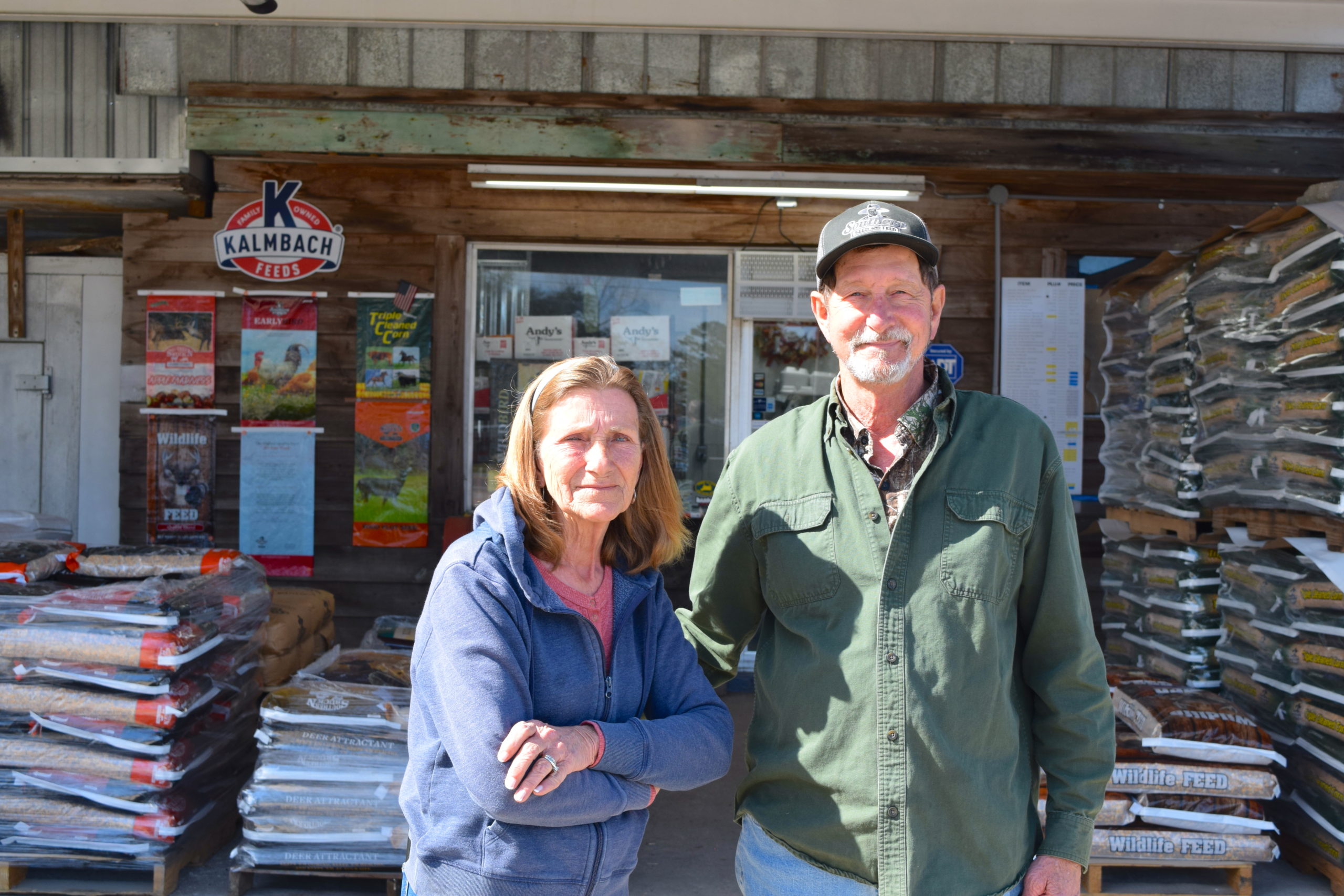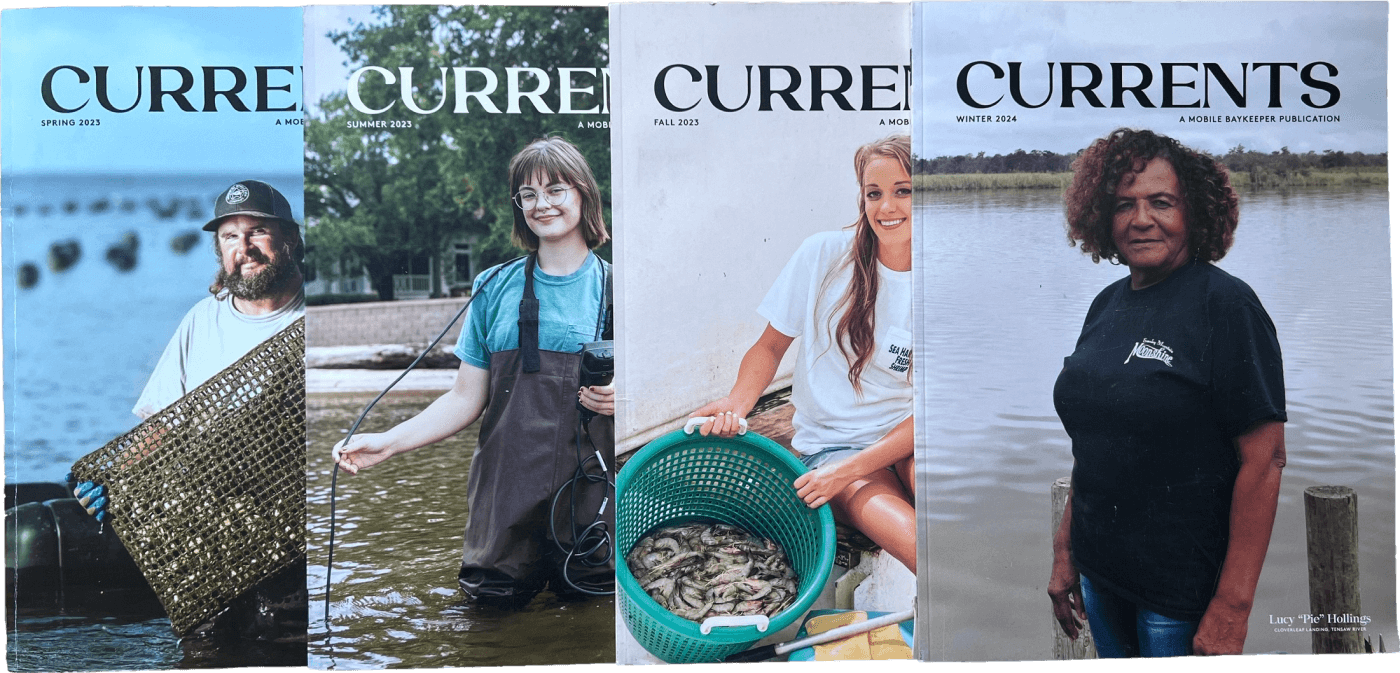
This article is from the spring 2024 edition of Mobile Baykeeper’s print quarterly, CURRENTS. The magazine is mailed to active members who have given more than $50 in the past year. To get on the magazine’s mailing list, donate here.
By Nick Williams | Photo by Caine O’Rear
“The only way to make sense out of change is to plunge into it, move with it, and join the dance.” — Alan Watts, English author
A lot has changed in my life during the last year. I’ve changed jobs. I’ve become an uncle. I’ve lost some friends. I’ve made some friends. I’ve picked up fly fishing, and mostly quit deer hunting. Most importantly, I’ve joined the ranks of fatherhood.
Kids embody change. First they barely open their eyes. Then they’re holding their head up. Then they’re babbling. Crawling. Talking. Walking. Getting their phone confiscated because they’re far too young to be texting boys that way … I’m not quite there yet with mine, so it’s amusing to hear the lamentations of a friend that is. But I know it’s coming for me, too, whether I’m ready for it or not.
As I sit at my desk and look out the window, chocolate-milk colored water has jumped the banks of the Tensaw and is flowing through the cypress and tupelos. Like kids, the Delta is an embodiment of change. Its waters rise and fall as easily as breathing. Its colors change annually from hues of green to shades of brown and gray. Its salinity changes. Most impressively, it cuts new channels. My house sits on a lake that was, a long time ago, the main channel of the Tensaw. LiDAR (Light Detection and Ranging) imagery shows some old oxbows that have silted in years ago and grown into forests. If the Delta is perturbed by these changes, it doesn’t show it. As Paul Robeson sang in the song “Ol’ Man River”: “He just keeps rollin’, he keeps on rollin’ along.”
This publication makes frequent mention of how people change their environment, but environments also change their people. Water people, in my experience, are Taoist in their view of change, although they may attend Baptist churches. They’ve learned that he who fights the current still flows with it, and that he who learns to swim with the current swims with the strength of the river behind him. The river’s changes, its floods, droughts, and storms, bring both risk and opportunity.
Recently I had a chance to catch up with a local couple that knows this very well. Joey and Ramona “Lil’ Bit” Kobitz, the proprietors of The Outdoorsman Seafood and Feed, make their living in large part by providing Gulf Coast residents with fresh Gulf and river seafood. Walk into their shop on Highway 225, and you’re greeted with the sweet, savory, and slightly spicy aroma of seafood.
In addition to crawfish, they carry and cook oysters, shrimp, snow crabs, and catfish. Fairly typical fare, but they also offer other delicacies such as alligator sausage and pickled quail eggs. On most weekends, the line extends out the door, where locals patiently wait their turn and trade in small talk around the pallets of deer corn and livestock feed out front.
Lil’ Bit runs the register, while her husband cooks and assists with loading feed. They’ve been at Crossroads for three years now, but it’s still the “new” spot to me. My wife and I were buying crawfish and Coca-Colas at their old place down by Whitehouse Fork Road when we were still just awkward teenagers. Fast forward 13 years, and I’m looking forward to introducing our daughter to Joey’s crawfish this spring.
Unfortunately, this year looks like it will be a rough year for both consumers and suppliers of crawfish. Joey let me know during my last visit that this year’s crawfish harvest will most likely be smaller than average, and pricier.
“The drought,” he tells me, “is what’s hurting them. It’s definitely killing off crawfish. But on the flip side, the oysters are really, really good. Because all across the Gulf Coast, the salinity has been pushed up. From here to Texas, everything is salty. That’s why your Louisiana oysters are so salty right now. Folks eat ‘em and say, ‘Are these from Texas? ‘Cause I know they’re not from Apalachicola.’ But yeah, they are. And what happened was, it was so salty that they couldn’t pump water out of the bayous into the crawfish ponds during the drought.”
“This summer, there were people catching flounder all the way up in Claiborne,” Lil’ Bit adds, referring to the tailwaters of Claiborne Dam on the Alabama River, which wind roughly 100 miles southward before they join Mobile Bay.
Changes in harvest bounty are to be expected when you work in the seafood industry. Species populations cycle up and down for a variety of reasons, and bad years are usually offset by good ones in the long haul. A bust year for crawfish, as Joey mentioned, can also be a boom year for oysters.
But some changes are harder to account for. The BP oil spill and COVID have both rocked the seafood industry in recent years, for example. Another problem is that competition from cheap, overseas seafood providers has made life difficult for local fishermen.
“Now,” says Joey, “if you’re still a shrimper, if you’ve still hung in there after the oil spill and COVID … you’re having to deal with the big-name restaurants buying imported seafood. The Gulf shrimping business is taking a hit, because now they’re having to sell their shrimp at or below cost to be competitive, especially since the price of fuel went up. And if it keeps up this way, you’re going to watch all the local guys go out of business.”
“Restaurants look at Gulf shrimp and import stuff, and they say, ‘Well, this [imported] stuff is cheaper, and it’s all just basically shrimp.’ But they’re not the same, I assure you! We’ve tried product from different countries, and it just doesn’t compare to local Gulf seafood. We get our product out of Bayou La Batre. Almost all of the local companies run out of there. I know all of those families. I’ve met every one of them. Dominick’s Seafood, for example. I know Dominick as a friend, and I can pick up the phone and call him anytime. Graham Shrimp Co. is another one, and Sea Pearl Seafood. They’re all right there on Shellbank Road, and they’ve been there forever. They’re family owned businesses, going way back. All good people, and they sell fresh seafood, and it’s not coming in from other countries.”
Aside from being a quality supplier of Gulf seafood, The Outdoorsman is also a hub for local hunters. Deer season finds the parking lot full of camo-clad outdoorsmen picking up deer feed, and maps for the local Mobile-Tensaw, Upper Delta, and Perdido WMAs sit on the counter. Joey himself is a member of Tensaw Hunting Club, one of the last dog hunting clubs left in Alabama. I’ve often driven by the club’s camp, located on the banks of the Tensaw River up by Devil’s Bend and only accessible by boat, and wondered what the hunting was like in the club.
“It’s changed over the years,” Joey confides. “Forever Wild bought the land around the camp, for one thing, and a lot of the old master hunters are gone now; the ones that really knew the river. There’s a few guys that carry it forward, but a lot of that knowledge and skill has been lost. It’s still a good club, and it’s got a lot of good people in it. But it’s more about the fellowship than the hunting now. We have a big, traditional, annual hunt every year, but people just don’t have dogs the way that they used to.”
“Another thing that’s changed,” he says, “is that duck hunting has just exploded in recent years, even though there aren’t as many ducks as there used to be.” As an avid duck hunter myself, who has read historic harvest reports for the area, I can attest to that. The average duck harvest per trip has decreased by 30 percent since the 1980s, according to the most recently published waterfowl report that the Alabama Department of Conservation and Natural Resources puts out.
A fresh wave of customers interrupted my conversation with Joey, and I was left to reflect on change by myself as he busied himself cooking a fresh batch of seafood. I confess that there are days when I’m easily discouraged by conversations about how our area has changed. As Colorado author and angler John Gierach wrote, “I don’t necessarily fear change, except that it’s so seldom for the better.”
But I’m encouraged whenever I watch waves lap at the shoreline. Every wave, you see, consists of two parts. The peak, and the trough. I’ve watched a lot of waves, and without exception every single trough has been followed by a peak. It may be just a fool’s hope, but I can’t help but believe that says something about how the universe works, and what the future holds for our local waters.
